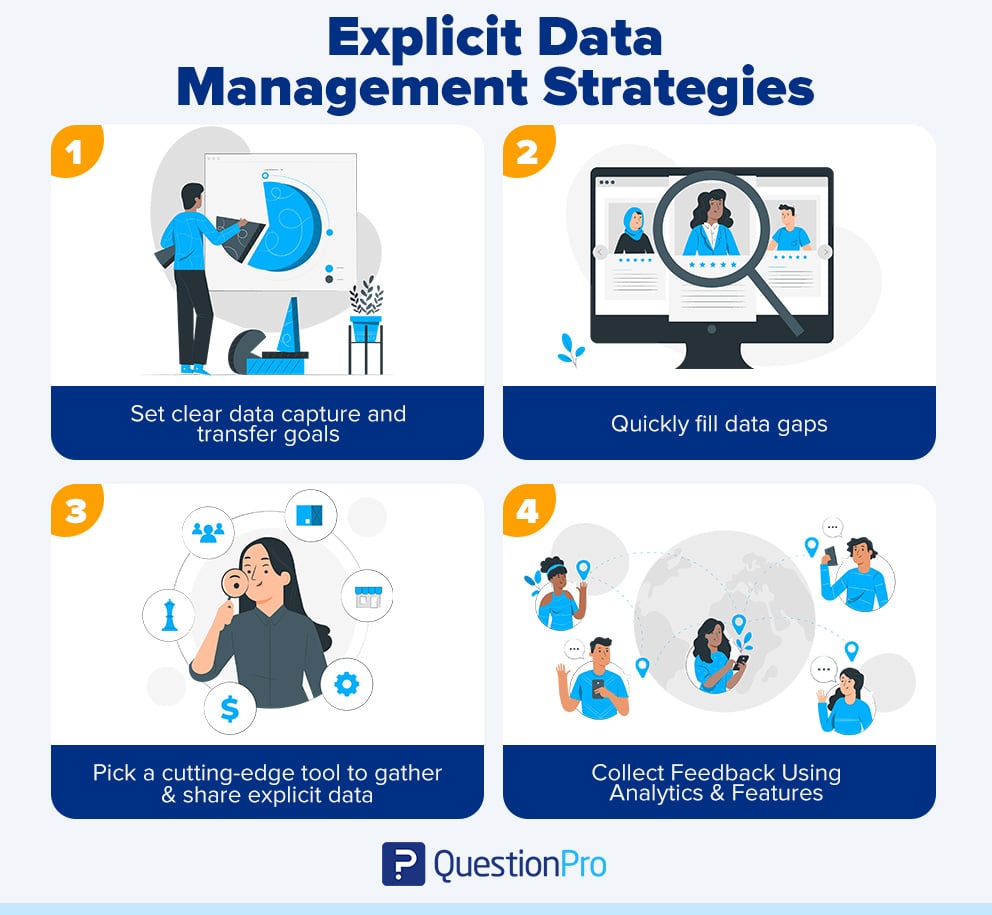
A database management system for your business may just be getting started. If so, you should be aware that explicit data is one of the essential kinds of data you can collect and disseminate to support your organization.
And if you fully get it, you can ensure your company’s success. Thus, we’ll cover everything you need to know about explicit data in this blog, including what it is, how to collect and store it, its advantages, strategies, and examples.
What is explicit data?
Explicit data is information purposely presented and accepted at face value without further interpretation or analysis. It includes details given in surveys and membership applications.
Explicit data is information and data that is easy to say, write down, and share. Let’s say you made a new WordPress app and wrote detailed instructions on how to use it. Those instructions are your explicit data. There must be more to this kind of information.
Unlike implicit data, which can only be extracted from examining explicit data, it is voluntarily submitted information.
Suppose, in an online membership application for a store, explicit information about the applicant’s residence and place of employment may reveal implicit information about the store they are most likely to visit and the best times to catch them there.
A more in-depth explanation of the explicit data practical guide
Explicit data is information that can be organized, stored, interpreted, and shared helpfully. This information is usually shared with others through databases, manuals, books, or videos that show how to do something.
Your company’s financial report, which shows how much money it makes and spends, is an example because other people can access, read, and use this information.
Capturing and storing your company’s explicit data effectively.
Explicit data can drive your organization or company’s growth, so it’s worth capturing and storing. Here’s how to do it:
- Accurately document your work:
Whenever you work on something new, try to write and collect vital explicit facts as documentation or books and keep them updated. Also, go through your documentation list and fill in data gaps, like:
- Inquire about data gaps and updates with your staff.
- Examine consumer comments to see where they need additional information.
- Assess the performance of teams that may use more information.
- Create explicit content creation guidelines:
Explicit data is a dynamic resource that changes as employees and team members affect your company’s development and structure. As your firm grows, a content production and development structure are vital.
Without a structure followed by the entire content creation team, personnel would write in different formats and styles, hindering workflow. You need a robust knowledge management system that gives you complete control over formatting and organization to ensure uniform documentation.
- Database documentation segmentation:
It’s no fun to browse through a sea of data and documents in your company library for a little piece of information. As your organization grows, the stored documentation might become tangled, making it difficult to find what you or your team needs.
If the correct information isn’t available when needed, it’s useless to your staff and customers. The solution is appropriately segmenting and categorizing an entire database from the outset.
Why is it good for your business to record explicit knowledge?
Now that we’ve defined it, you might wonder why you should collect and share explicit data. Here are the leading causes:
- Create an employee knowledge base.
Creating an internal database with the company, product, and service information and making it accessible to employees can help your firm in numerous ways. Existing personnel can refine their knowledge and abilities while training new ones.
When your organization has internal data documentation, it’s easy to learn about its status, new projects, etc. They’ll also have access to the information and resources needed to make faster, smarter decisions for your company.
-
Improve customer service and communication.
Documenting explicit data for your company improves employee communication because everyone can view, read, and understand the same information.
It also helps your support personnel provide better customer care because they can access all facts and data without asking seniors. They can communicate clearly what needs to be done or fixed.
-
Boost credibility and avoid errors.
In line with the goal of clear communication, writing down your policies and procedures as explicit data for your team will make it less likely that employees will make mistakes. When doing a task or helping a customer, employees can look at the existing documentation to follow the proper procedures and do their work correctly.
-
Easily track progress and avoid duplication.
Organize explicit data in your company’s information base under your brand name to keep track of several projects and responsibilities. So, the organization’s solutions can be documented and used again.
Employees might learn from others’ triumphs rather than solve comparable difficulties from the beginning. This understanding can help ensure no team members replicate documented facts or information. There will be less time wasted redoing work.
-
Prevent company data loss
How can explicit data storage help your organization avoid information loss? If a critical member of your team leaves, they can create a data gap, especially if they were the only ones who knew how to handle a crucial aspect of your business. If you document valuable data, you can ensure that doesn’t happen, and no one can copy it.
-
Improve products and procedures.
Explicit data allows you to build standardized methods and procedures that help your organization excel. Simply capture, save, organize, and share your company’s common knowledge.
You can use it to produce new ideas and improve your business, ensuring exponential growth.
Explicit data management strategies
Documenting and maximizing explicit data is tricky. This challenge demands planning, strategy, and a dependable data management system because it allows your organization to utilize its knowledge and achieve financial success ultimately.

-
Set clear data capture and transfer goals.
You should define clear objectives to capture and transfer your work’s explicit data. Identifying when and how your organization loses expertise and what information your staff needs is essential. Based on these theories, create short- and long-term goals.
-
Quickly fill data gaps.
Next, track your information gaps in the database and which documents need updating, as we’ve said. See which subjects are missing or how one copy may be enhanced. Ask your employees what knowledge they want to document. Look at your procedures to identify which tasks should be recorded.
But suppose you don’t have the tools and solutions to gather your data and show it appealingly. In that case, you can’t manage your explicit data. Because a data management system is essential to your plan, you require a tool to help you manage data centrally while allowing contributors access to the system.
-
Collect Feedback Using Analytics & Features
To design the most excellent website documentation and evaluate its success with in-depth analytics and reporting. Practical business intelligence relies on the synergy between analytics and reporting, where analytics uncovers valuable insights, and reporting communicates these findings to stakeholders. Ask consumers, website visitors, or teammates if they find your information beneficial and easy to understand.
LEARN ABOUT: Best Data Collection Tools
Conclusion
Consumers actively submitting the information are explicit data. Names, gender, email addresses, and home addresses are often given after a customer’s first transaction or when signing up for a newsletter or other information online.
From this data, companies can tweak settings to give options likely to attract buyers, such as highlighting popular fashions in their location.
QuestionPro is more than just survey software because it provides solutions for every problem and business. Additionally, we have data management tools like our research repository: InsightsHub.
LEARN ABOUT: Customer data management
Organizations worldwide are using knowledge management software and systems, like InsightsHub, to improve data management strategy, shorten the time it takes to get insights, and better use historical data while lowering costs and boosting ROI.







